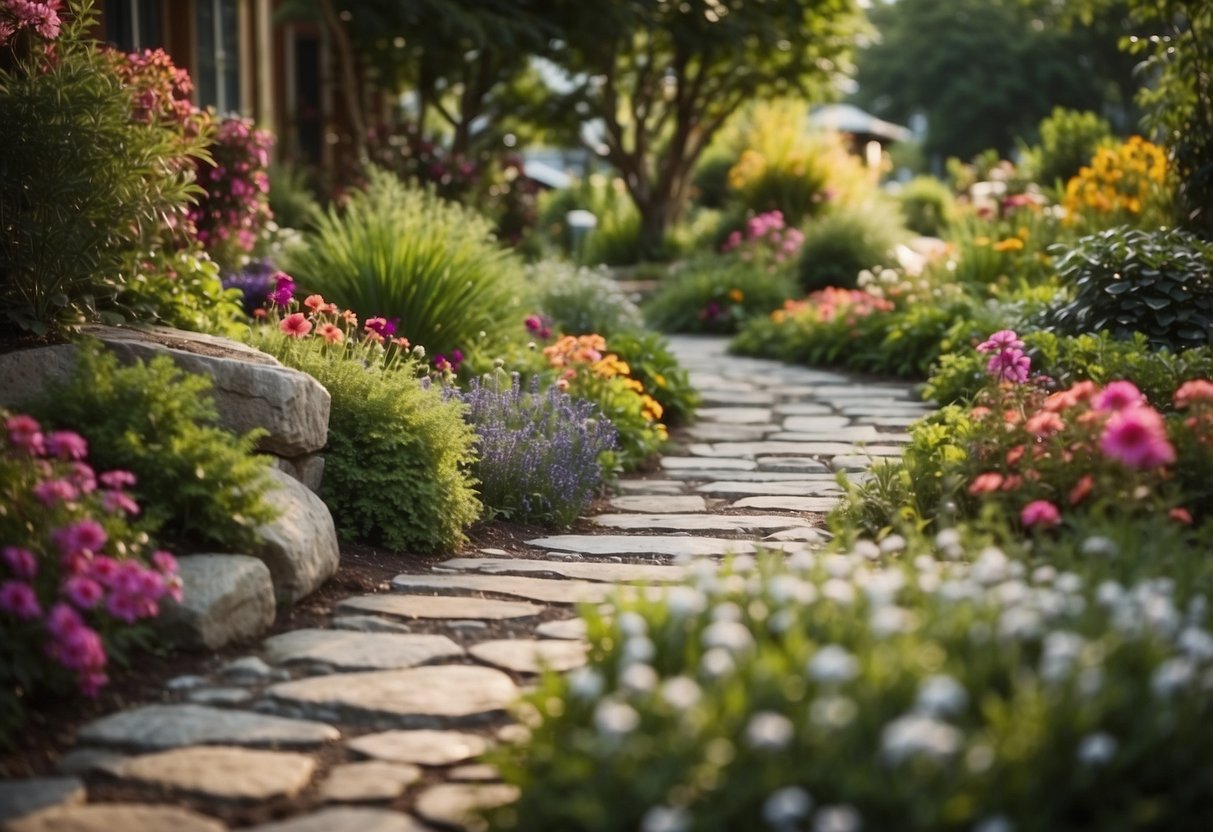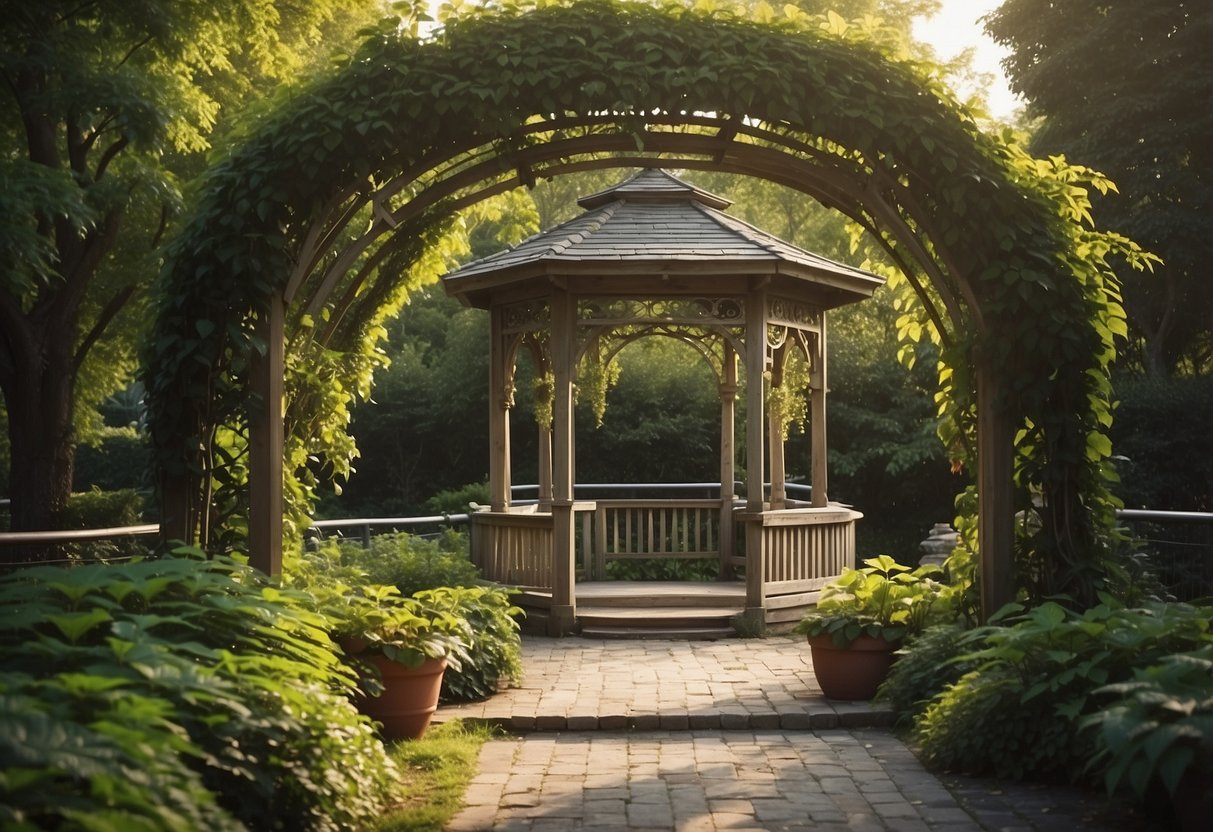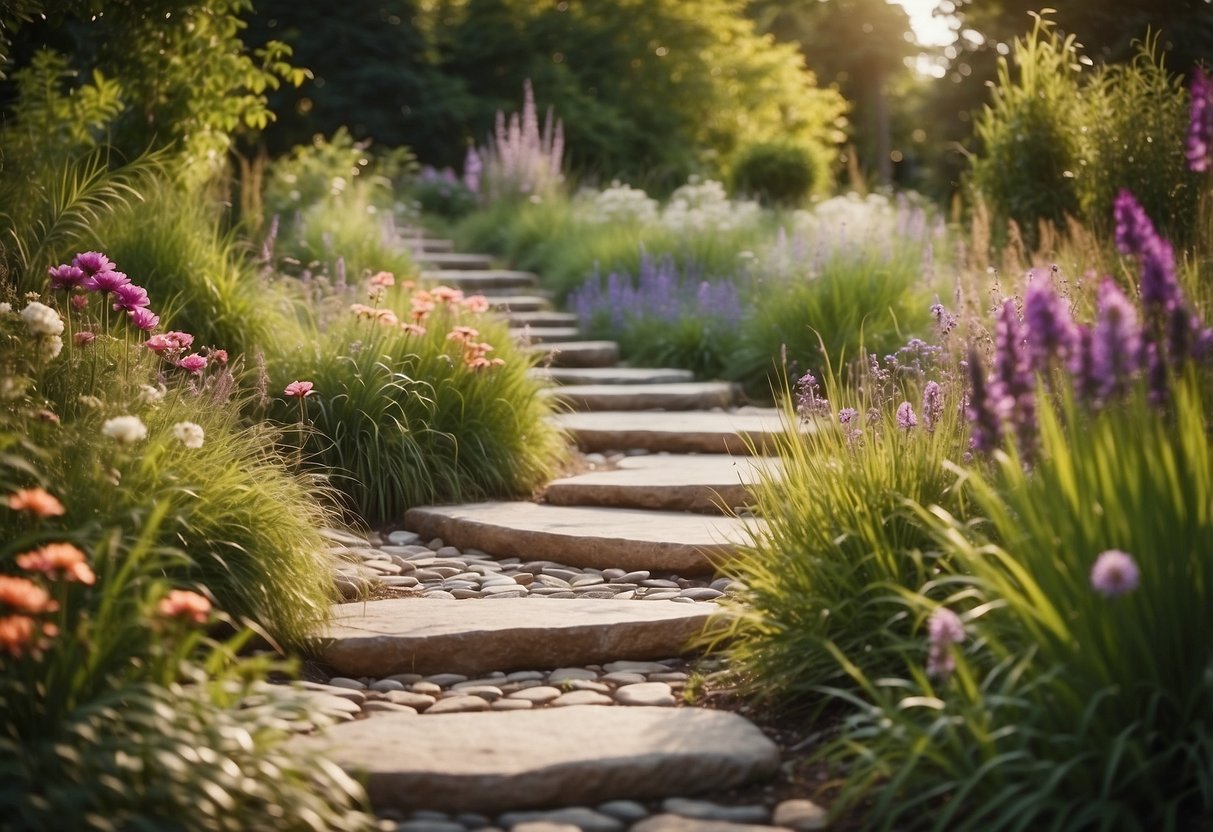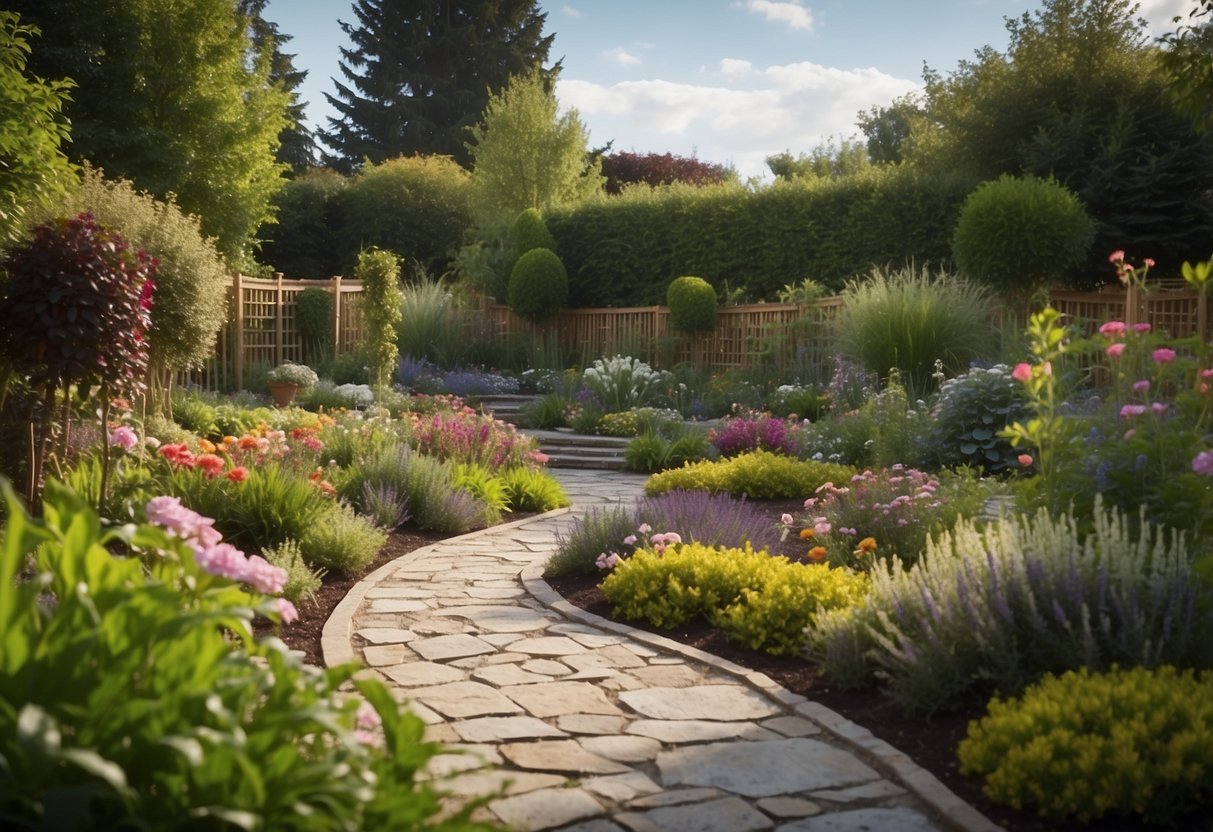Garden Hardscape Ideas: Transform Your Outdoor Space
Transforming your backyard into a stylish and functional sanctuary can be achieved by adding hardscaping elements. These built features, like patios, paths, and walls, not only enhance the beauty of your garden but also bring structure and organization to your outdoor space. Hardscaping helps define different areas of your garden making it more inviting and practical.

You’ll discover that a well-planned hardscape can significantly elevate the aesthetics and usability of your outdoor environment. Whether you’re looking to create a cozy retreat or a lively entertainment area, incorporating hardscape ideas can make your garden truly stand out.
1) Flagstone Pathways

Flagstone pathways add charm and elegance to your garden. They create a natural look and blend well with most outdoor spaces. You can arrange the stones in various patterns, such as a winding spiral or straightforward path.
Fill the gaps between the stones with materials like grout, grass, or river pebbles. This gives a clean and polished appearance while preventing weeds from growing.
Flagstone is durable and can withstand changing weather conditions. This makes it a practical choice for long-lasting garden paths.
2) Gazebo with Climbing Vines

A gazebo covered in climbing vines can add a touch of magic to your garden. Imagine sitting under a canopy of lush, green leaves and colorful flowers.
Choose vines like wisteria, ivy, or honeysuckle. These are known for their ability to grow quickly and cover structures beautifully. You can find more ideas on HGTV.
Make sure to provide a sturdy support for the vines. As they grow, they will need something to cling to. The end result is a gazebo that looks like it’s part of the landscape.
3) Stone Fire Pit

A stone fire pit can turn your garden into a cozy gathering spot.
You can use various types of stones like multi-color slate or flagstone, which provide a rustic charm.
Adding native plants like succulents or cacti around the fire pit can enhance the natural look while being low-maintenance.
For more ideas, check out stone fire pit designs.
4) Retaining Walls with Plants

Retaining walls can add both structure and beauty to your garden. To make them even more engaging, you can plant greenery directly within or above the wall.
Plants like creeping thyme or lavender spill over the edges, adding a soft touch. You might also consider ferns or hostas for shady areas.
Adding plants to your retaining walls not only makes them aesthetically pleasing but helps with soil erosion and drainage. For more ideas, check out this guide.
5) Pergola with Hanging Plants

Transforming your garden with a pergola and hanging plants can create a cozy and inviting space.
Imagine relaxing under a wooden structure adorned with lush greenery. The hanging plants add a natural touch, providing shade and beauty.
You can choose colorful flowers or green vines to personalize your pergola. This setup not only looks great but can also help you unwind. For more ideas, visit 22 Pretty Pergola Ideas.
6) Garden Benches

Adding a garden bench can create a cozy spot for relaxation. You can choose from various designs, like a classic wooden bench or a modern metal one.
Some benches even offer extra features, like storage under the seat. This can be useful for keeping gardening tools handy.
For a playful touch, consider a low bench that kids can climb on.
7) Water Fountain Feature

Adding a water fountain to your garden can create a peaceful and beautiful environment. Fountains come in various designs ranging from traditional to modern styles.
A Japanese fountain can bring a touch of calm to your space. For a sleek, contemporary look, consider a concrete pedestal fountain with straight lines and a bubbler nozzle, which creates a subtle yet relaxing sound as the water falls into the basins below.
For more ideas, visit HGTV’s water feature suggestions.
8) Rock Garden with Succulents

Rock gardens are beautiful ways to showcase your succulents. By using a variety of rocks, you can create interesting shapes and textures.
Stack flat rocks to add height to low-growing succulents. This not only enhances the display but also introduces different levels to your garden.
Scattering large, flat stones around your succulents adds color and texture. This creates a delightful contrast against the plants. Use small pebbles as fillers between larger rocks and plants for a polished look.
Consider adding creeping groundcovers to soften the hard edges of rocks. These plants blend beautifully with succulents and add a lush feel to your garden. For more ideas, check out rock garden ideas.
9) Brick Patio

A brick patio adds charm and warmth to your outdoor space. It’s a classic choice that fits well with many backyard styles.
You have two main options: sand-set brick and mortar-set brick. Sand-set is cheaper but might become uneven. Mortar-set brick stays flat and repels ants.
Brick patios are easy to keep clean. Use vinegar, hydrogen peroxide, or power-washing to maintain their look. Check out more brick patio ideas for inspiration.
10) Gravel Walkways

Gravel walkways are a charming and practical addition to any garden.
You can choose from various gravel options, like pea gravel or crushed stone, to suit your style.
Gravel paths are easy to install and maintain. They also add texture and definition to your garden.
You can create beautiful borders using larger rocks or plants to keep the gravel in place. Using a strip of larger rocks can help prevent the gravel from spreading into your lawn, avoiding potential damage to your lawn mower.
Explore more designs at 75 Gravel Garden Path Ideas.
Understanding Garden Hardscaping

Hardscaping is all about adding non-living elements like patios and walkways to your garden. These elements not only enhance the look but also increase the functionality of your outdoor space.
What is Hardscaping?
Hardscaping involves incorporating structures and materials such as stone, concrete, and brick into your garden design. These can include patios, walkways, and retaining walls.
Unlike softscaping, which deals with plants and greenery, hardscaping focuses on the durable framework of your outdoor area. Paths and steps made of gravel or pavers help guide visitors through your garden, while retaining walls can control erosion and add different levels to your landscape. Materials like wood and metal can also be used for features like fences, decks, and pergolas.
Benefits of Hardscaping
Adding hardscaping elements to your garden offers several benefits. First, it provides structure and organization to your outdoor space. This helps you define areas for different activities, like relaxing or dining.
Hardscaping materials are also typically durable and require minimal maintenance. For example, a well-built patio or driveway using concrete or stone can last for many years.
Additional benefits include improving drainage and reducing erosion, especially when you use retaining walls. A fire pit or outdoor kitchen can also boost your home’s value and make your backyard a more enjoyable place for family gatherings. By integrating these elements, you can create a balanced, beautiful, and practical garden.
Design Principles for Garden Hardscaping

When planning garden hardscaping, focus on creating a cohesive outdoor space by balancing the natural elements with built structures. Thoughtful material choices and placement can enhance your garden’s beauty and functionality.
Balancing Softscape and Hardscape
Blending plants (softscape) with structures (hardscape) helps create a harmonious garden. Avoid overwhelming your space with too many hard surfaces. Instead, use them to complement your greenery. Pathways, patios, and benches can be combined with flower beds, shrubs, and trees to create visual interest.
Consider scale and proportion. Ensure that the size of the hardscaping elements matches the space and the height of plants around them. For instance, large patios suit big gardens while small courtyards benefit from compact designs.
Use transitions to connect different areas. Incorporate stepping stones or gravel pathways to lead visitors through various garden zones. This intermingling of soft and hard elements creates a natural flow throughout the space.
Choosing Materials
Select durable materials that match your garden’s style and climate. Common hardscaping materials include stone, concrete, and brick. Stone, such as granite or slate, offers a natural look and is very long-lasting. Concrete is versatile and can be molded into various shapes, while brick provides a classic and warm appearance.
Take maintenance into account. Opt for materials that require minimal upkeep. For example, concrete pavers are easy to clean and replace, if necessary. Gravel is a low-maintenance option for paths and driveways.
Think about color and texture. Choosing materials with colors that complement your plants can enhance the overall aesthetic. Smooth textures work well for modern designs, while rough textures add rustic charm. Make sure the materials feel good underfoot and are safe to walk on.
You can find more ideas and materials at Hardscaping Ideas: Transform Your Outdoor Space with Creative Designs and Hardscaping 101: Design Guide for Paths and Pavers.
Maintenance Tips for Hardscaped Gardens

Maintaining a hardscaped garden can be simple if you know what to do. Here are some friendly tips to keep your outdoor space looking great.
Regularly sweep surfaces like patios and walkways to remove dirt and debris. This helps prevent stains and keeps your garden looking fresh.
Power wash stone, concrete, and brick surfaces occasionally. This will remove built-up grime and keep your hardscaping vibrant.
Inspect joints in your patios and walkways. Reapply joint sand or filler material if needed to prevent weeds from growing in the cracks.
Trim any plants or bushes that are close to hardscaping elements. This prevents roots from damaging the structures.
Check for signs of erosion. A permeable surface helps reduce runoff and erosion, which can damage your hardscaped areas. Learn more about sustainable design tips.
Seal your hardscaping elements like patios and walkways every few years. This adds a protective layer and helps resist stains.
Tools You Might Need
| Tool | Purpose |
|---|---|
| Broom | Sweeping debris |
| Power washer | Cleaning surfaces |
| Joint sand | Filling patio joints |
| Pruning shears | Trimming plants |
| Sealant | Protecting hardscapes |
Make sure to follow local guidelines for water use when power washing or sealing your hardscape elements. This will help your garden stay eco-friendly while looking its best.
By keeping up with these simple tasks, you’ll enjoy a beautiful, low-maintenance garden. Check out more hardscaping ideas to inspire your outdoor space.







